FC Trastevere shows grass is often greener in Italian soccer’s bush leagues
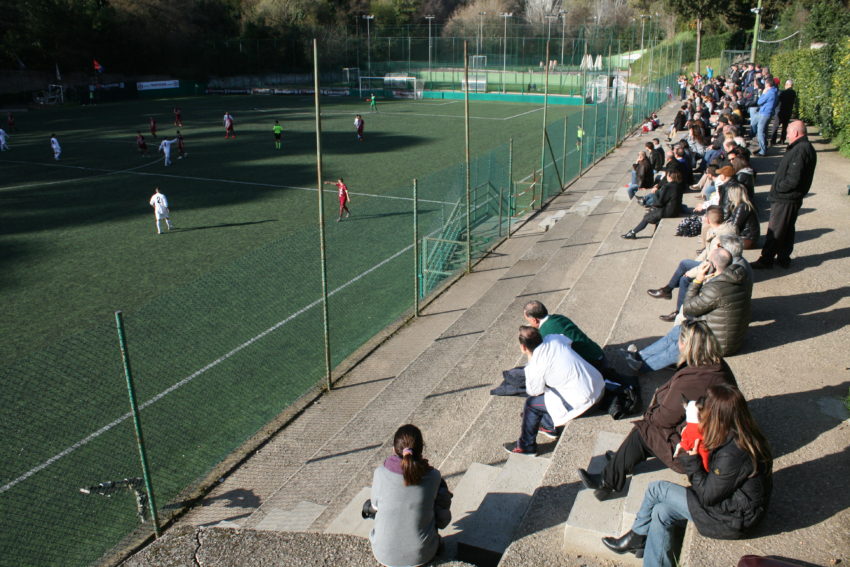
After more than two years in Rome, I sense a transformation. I am slowly becoming Italian. I don’t look or sound more Italian. My brown hair and American face, deeply rooted in Anglo-Saxon heritage, still look lifted off a Chevrolet commercial. My Italian sounds more German than anything that could make women swoon. But I can make a mean cappuccino and have developed an Italian’s begrudged acceptance of Italy’s third world public services. I always choose wine over beer, and it does matter what shoes I wear. I also feel something else, a love that is reaching the level previously achieved for Italy’s food, wine, women and art.
Soccer.
I have become “pazzo per calcio.” I am crazy for soccer . I schedule my weekends around trips to my local Moonlight Cafe to watch A.S. Roma games. I am reading the “Mercato” section of the sports dailies to see what players in Italy are moving where. I find myself staying home Monday nights to watch televised games in Lega Pro, Italy’s third division. Normally, sitting home in Rome watching a soccer game in a near empty stadium between teams from towns I can’t pronounce let alone locate would be a frantic cry for help. I find it peaceful. Besides, I get travel tips. Last week I watched Cittadella play. I learned it’s a town of 20,000 northwest of Venice and surrounded by a huge round wall left over from when it was a military outpost in the 12th century. It’s perfect for a weekend getaway or a break from Venice. And I might be able to take in a soccer game.
This lower level of Italian soccer is where I’m finding new joy. I’ve peeled away the sterile veneer of Serie A, Italy’s top classification, and uncovered an all new level of culture. It’s kind of like cooking in Italy. The longer you’re here, the more different pastas you discover and cheeses you can try. Some are better than others but they’re all good. It’s at this level, these Italian bush leagues, where I found myself enjoying a very different Sunday afternoon in Rome.

In all this time I never knew Rome had a third pro soccer team. It not only has one, it’s right across the Tiber River from me. In fact, FC Trastevere was founded in 1909, just eight years after an Italian, Guglielmo Marconi, invented the radio and 18 years before A.S. Roma formed to create a white-hot cross-town civil war with Lazio. Trastevere has been playing primarily in Serie D, Italy’s fourth division, the equivalent of American baseball’s Class A. Picture New York City with a low minor league team and you have FC Trastevere. In fact, I’ve done this before. While working at The Denver Post, I did a feature on the Brooklyn Cyclones, a Class A team on the other end of New York from the Yankees and Mets. The date I saw them was Sept. 4, 2001. Exactly one week later, terrorist attacks leveled the World Trade Center Marriott where I stayed.
My pregame meal that day was a Coney Dog on Coney Island, not far from the stadium and as deeply rooted in American history as baseball. This time I was in Trastevere, like Brooklyn, one of the most multi-layered neighborhoods in its city. Formerly settled by ancient Etruscans, Trastevere became the home of sailors and fishermen during the Roman Empire and soon was the in place to live. Julius Caesar had a garden villa there. Throughout the centuries, it remained terribly hip. By the 1960s and ‘70s, it became a beehive for Italy’s artists and writers and communists, a bohemian melting pot of ideas, radicalism and really good pizza. Today, it has long since gentrified. Its narrow, windy, cobblestone alleys are teeming with tourists and overseas students checking out street art, cozy cafes, rollicking beer bars and independent bookstores.
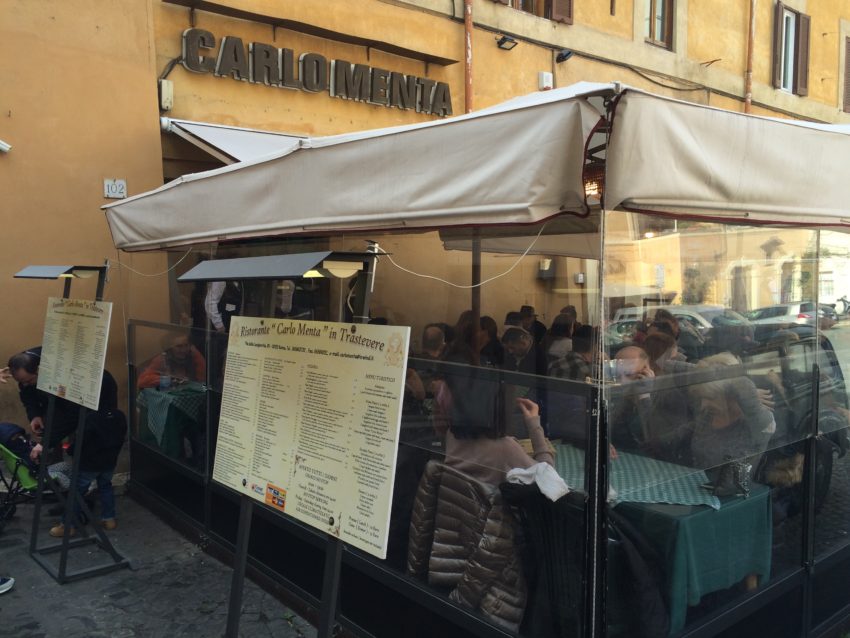
In the heart of Trastevere is a restaurant called Carlo Menta. It has occupied this corner of Via Lungaretta since 1808. It is here where I met Alessandro Castellani, my good friend and sportswriter who tipped me off on FC Trastevere, and his colleague at ANSA news service, Fabrizio Innocenti. Carlo Menta may be the most touristy restaurant in Rome. Every time I walk past it, the covered patio area is jammed. I hear more foreign languages than Italian. It’s like walking past a United Nations cafeteria. When I sat down and looked at the menu, I found out why. It may be the cheapest restaurant in Rome. Pizzas for 4 euros, pasta for 5. My scalloppina, veal smothered in cheese and basil, was 5 euros. This was sticker shock in reverse. I saw restaurants in rural India more expensive.
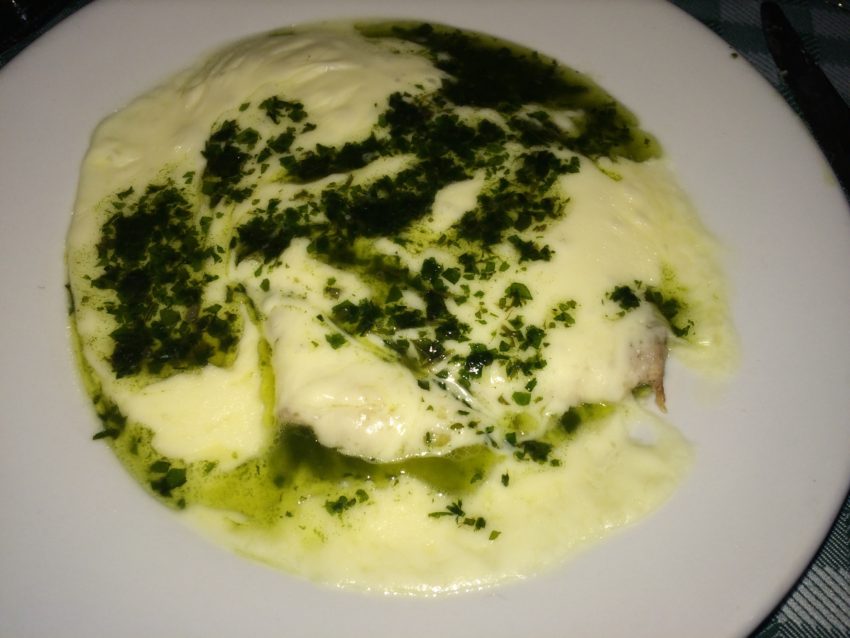
Soon joining us was Pierluigi Betturri, the owner of Carlo Menta and, as it turns out, FC Trastevere. Where else but Class D soccer can you have lunch with the owner before watching his team play? I doubt the media in Milan lunch often with Silvio Berlusconi, owner of A.C. Milan. Well, if the reporter is a buxom 17-year-old girl maybe but …
… anyway, Betturri is an easy-going 50ish Trasteverino. Dressed casually in a pinstriped coat with elbow patches, he gave me a history lesson about the team I never knew. Benito Mussolini knew it. In 1939, when he was jackboots deep into power, Italy’s then-daily sports newspaper, Littoriale, wrote about the 30-year anniversary of FC Trastevere. Francesco Totti, the greatest player Rome has ever produced and the best in A.S. Roma history, started his youth career with FC Trastevere at age 11.
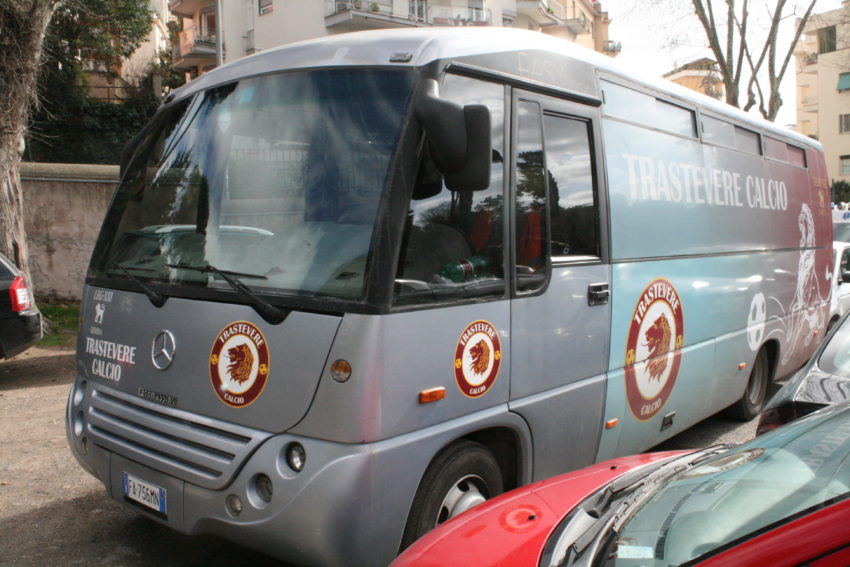
Only once, in 1946-47, did Trastevere ever reach as far as Serie B. Two or three times it made Serie C. The rest of its history has been at Serie D, so far down Italian soccer’s social structure you need scuba gear to locate the standings. Yet in reality, to show the depth of interest and popularity in this soccer-crazed country, Serie D is only halfway down. Here is the hierarchy of Italian soccer:
Serie A
Serie B
Lega Pro (Serie C)
Serie D
Eccellenza
Promozione
Prima Categoria
Seconda Categoria
Terza Categoria
Serie D is about the last level of professionalism. The salaries are so low the league is considered semi-pro. Older players get about 1,000 euros a month; younger players get about 100. Nearly all have other jobs. Trastevere’s coach, Sergio Perozzi, is the mayor of Amatrice, the Lazio town where they invented the famous Roman dish, pasta amatriciana, in the 18th century.
“You, me, Fabrizio and eight others could form a team in Prima Categoria,” Alessandro told me.
But the layers of Italian soccer speak to the soccer talent in Italy that’s as deep as the Adriatic Sea. Serie A has 20 teams. Serie B has 22 teams. Lega Pro, the sportswear company that sponsors Serie C, has three leagues (or girones) totalling 54 teams. Serie D has nine girones and 171 teams. From the smallest fishing village in Sicily to mountain hamlets near the Swiss border, there is a pro soccer team. With most rosters at 25 players, that means the 267 pro teams in Italy have 6,373 pro players. Also, below Serie A, they are nearly all Italians. Pro baseball in America has 4,400 players on 176 teams and 26 percent of the 625 major league players last year were foreign born. The U.S. has a population of 319 million; Italy has 60 million. You do the math.

In Rome, however, soccer is a mess. Last month Lazio’s fans had their eighth racist incident in three years. They screamed racist chants at Napoli’s Kalidou Koulibaly, a Frenchman with Senegalese roots. Curva Sud, the section of A.S. Roma’s vicious Ultras fan base, has been empty nearly all season. They have protested the team doing nothing to stop the city from putting a divider in Curva Sud to help control the chaos. The section has remained nearly empty. Attendance has plummeted and the in-stadium atmosphere is on the level of a company picnic game. A favorite to win its fourth Serie A title, or scudetto, A.S. Roma went on a 10-game winless streak and fired coach Rudi Garcia. They hired Luciano Spalletti, whom they fired in 2006. They’ve won five straight in Serie A but he blew his homecoming Sunday by telling Totti at a team breakfast to go home after he told a TV station he wanted to play more. Betturri responded Tuesday by sending a letter to Totti, telling him to come back to the team that gave him his first chance.
Only in Serie D.

I would love to see the icon of Rome soccer, Francesco Totti, walk into the FC Trastevere stadium as I did later that day. Campo Vittorio Bachelet, straight up the hill from Trastevere, sits high above Rome, hard against Doria Pamphilj, Rome’s largest park at 445 acres and former 17th century villa of the Pamphili family. As I took my seat in one of the five rows of concrete stands, I looked across the artificial playing field and saw an entire forest of the park’s Acacia trees on the other side. Where the Pamphilis once hunted wild boar, FC Trastevere hunts teams from villes like Rieti and Budoni and Olbia. Ostia Mare is in Ostia, Rome’s beach neighborhood and is technically Rome’s fourth team. Last-place Astrea is made up of guards from the Casal del Marmo prison.
The Premiership this is not.
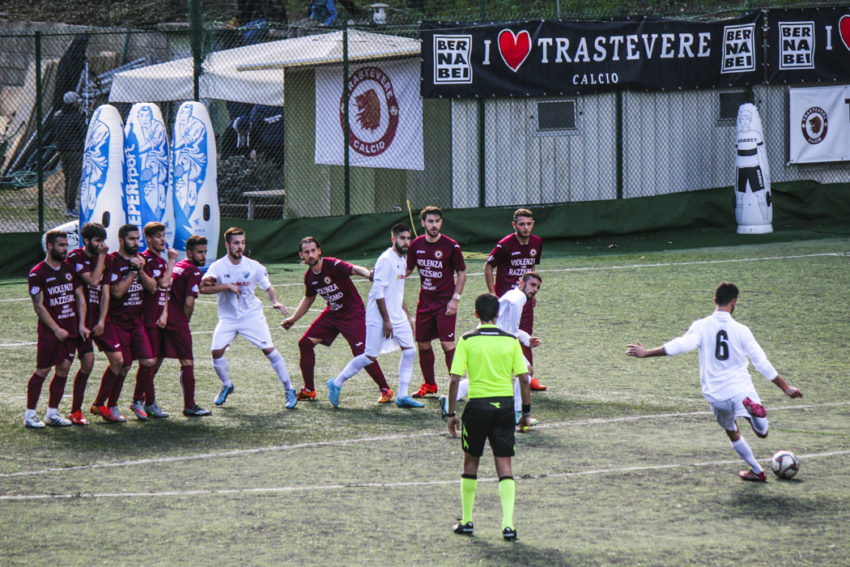

Yet the quality of play is shockingly high. Trastevere is ninth in the 18-team Girone G and played Cynthia, fighting relegation in 16th place. Cynthia (pronounced CHIN-zia) is from Genzano, one of the Castelli Romani towns sporting castles in the glorious green hills south of Rome. Genzano is famous for arguably the best bread in Italy and was known during the Roman Empire as Cynthianum. Cynthia’s name dates back 2,000 years. And I thought the New York Yankees were old.
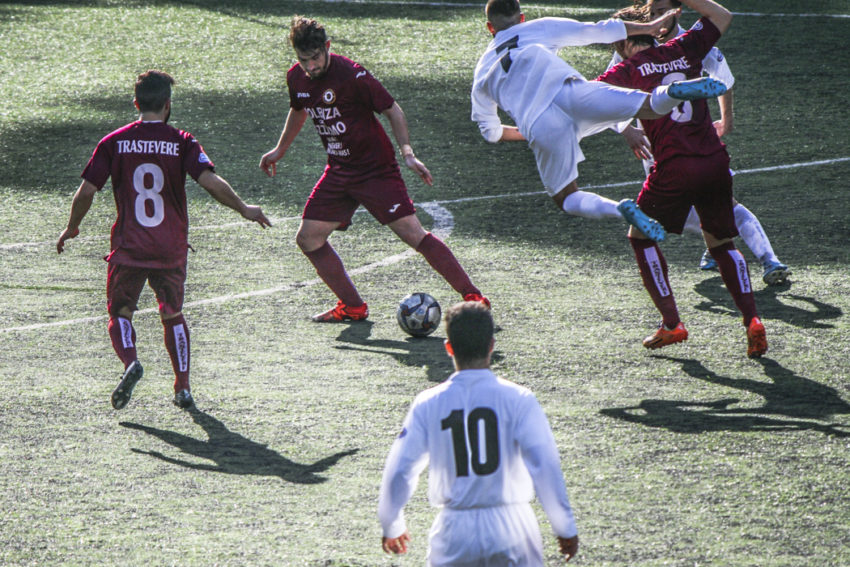
They call soccer “The Beautiful Game” and this contest in the bowels of Italy’s professional ranks proved why. This collection of pros on meager wages, who work part time in offices and bars and banks, are really good. Wearing red shirts with “VIOLENZA, RAZZISMO MAI” (VIOLENCE, RACISM NEVER), Trastevere had players as fast as I’ve seen in the Olympic Stadium. So did Cynthia. Their ball handling was remarkable. Their passes were crisp. Their goalkeepers were sure handed and aggressive. Just last month Juventus, the four-time Serie A defending champion, signed Alessio Di Massimo from Serie D Avezzano. And, just like the highest-salaried players in Europe, they fake injuries with the zeal of Broadway actors. One Trastevere player got clipped and fell with a wailing cry as if hit by a sniper.
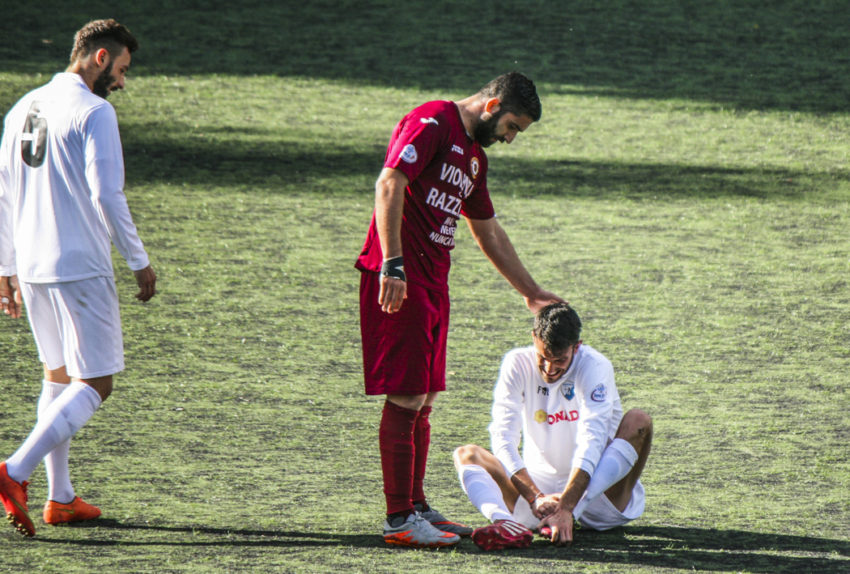
From the fourth row, I could hear it all. Never in my trips to the Olympic Stadium have I heard players yell at each other.
“VAI A SINISTRA! VAI A SINISTRA!” (“GO TO THE LEFT! GO TO THE LEFT!”)
“ORA! ORA! ORA!” (“NOW! NOW! NOW!”)
“CHE CAZZO?” (“WHAT THE FUCK?”)
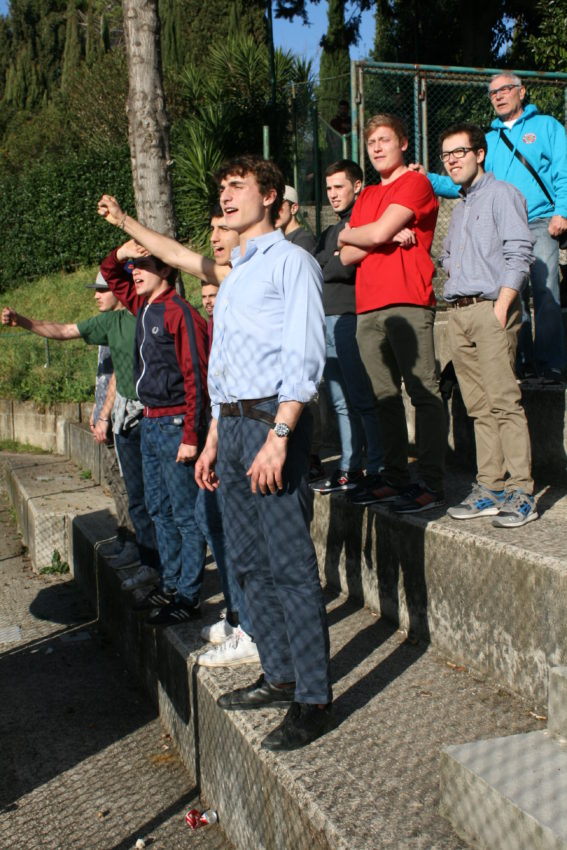
Sure, one Cynthia player kicked a pass nearly into the trees and another’s header went softly over his goalkeeper’s head into their own goal for a 1-1 tie. But the proximity to the gorgeous field, the warmth of a 60-degree day and the skills of players who play for the love and not the money made this one of the best 10-euro buys in Rome. This is sport at its grass roots level, like a warm summer night in a small Midwest town in the U.S. watching a minor league baseball game. But this is definitely soccer. A group of a dozen young men, constituting Trastevere’s tiny posse of ultras, sang songs in the corner of the grandstands. Keeping to the family atmosphere, they were clean.
“NON SO STARE SENZE TE.
TI AMO, TRASTEVERE!”
(“I CAN’T STAY WITHOUT YOU.
I LOVE YOU, TRASTEVERE”)
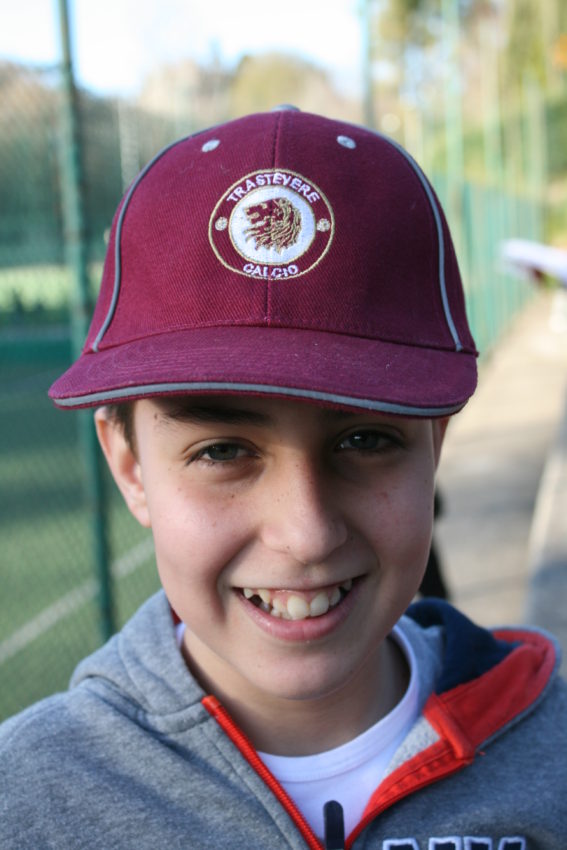
Then came a moment that bridged the gap between Serie D and the top soccer in Europe. It stretched all the way to the height of the Premiership, to a goal Cristiano Ronaldo and Lionel Messi would include in their highlight film. Lorenzo Pace, a tiny player for Cynthia, waited under a ball floating in the middle of the 18-meter box. Suddenly, Pace jumped high and bicycle kicked it into the upper right-hand corner of the goal for the final goal in a 2-2 tie. It’s a goal you wouldn’t see in a 100 Premiership games yet Pace is just one of thousands of Italian players playing that day.
After the game, I saw him sitting at a table next to the stadium cafe. He was waiting for a ride back, just like a youth league player. He still lives with his parents in Lanuvio. Only 20, the half Indonesian signed with Cynthia last month after playing for Lazio’s development team. I asked him if he ever scored a goal like that.
“In December,” he said, not nearly as impressed as I was.
I saw Betturri and asked him where they would play if they ever won their Girone, got promoted to Lega Pro, then finished in the top four for promotion to Serie B. It’s not unprecedented. Chievo, a neighborhood in Verona, has gone from Secondo Categoria to Serie A. Could he imagine a derby versus A.S. Roma? Not in Campo Vittorio Bachelet. It seats about 500 people. About 300 attended Sunday. They could play in Rieti. If Rome gets the 2024 Olympics, perhaps the city will refurbish 30,000-seat Stadio Flaminio, built for the 1960 Olympics but since closing in 2011 it, has gone to seed, a derelict stadium of weeds and cracked concrete.
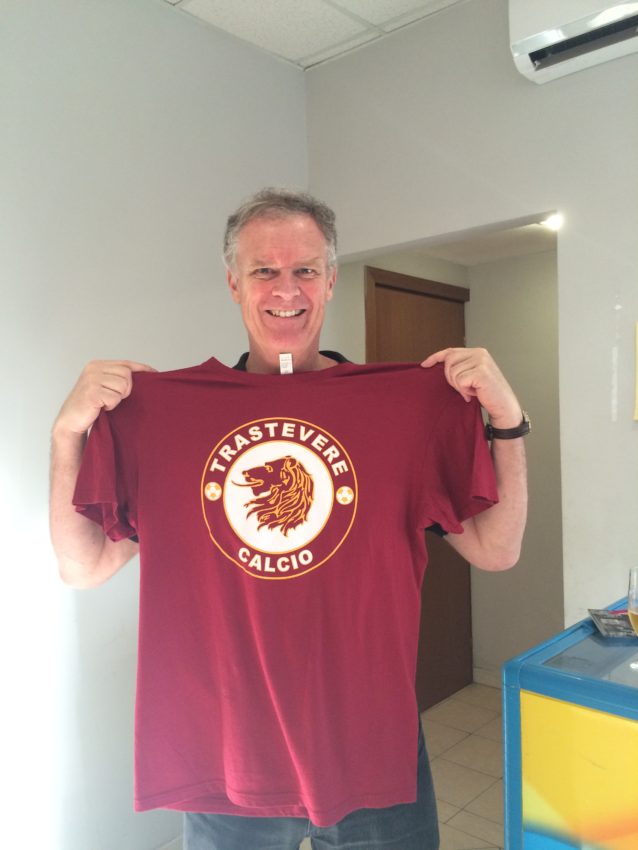
That’s a long time and many victories away. I wasn’t thinking about its future as I drank a beer with the club’s front office staff in the cafe. His son gave me a beautiful FC Trastevere T-shirt, red with the lion logo, and refused the 10-euro note I tried forcing down his throat. He wants to open a souvenir shop next to Carlo Menta. I told him it will be a major hit with American sports fans cruising Trastevere with a few euros in their pocket and a few beers in their belly.
Later that night, I watched A.S. Roma bludgeon Palermo, 5-0, from a sterile dining room of a Brazilian bar. I reviled in the victory but shivered in the sterile atmosphere. In a city where beauty is the most valued of qualities, The Beautiful Game has no boundaries.


February 25, 2016 @ 9:32 am
Nice story John! And you know how NOT a sports fan I am, so that’s saying something!
March 4, 2016 @ 12:48 am
Just saw this comment, Lisa. Yes, coming from you, a non sports fan and a journalist, it is the ultimate compliment. Grazie mille!!!
April 2, 2017 @ 1:48 pm
My wife and I will be in Rome from May 7th until the 14th. We will be staying in Travastere the entire time, and I thought it might be fun to see their football team play, especially after reading your article.
I cannot find a schedule for the Trastevere team for this season, and wondered whether you might know if they have a home match during our visit. Also, I collect hats of sports teams, and thought it would be great to probably be the only person around with an D.C. Trastevere hat. Any idea where they can be purchased?
Any information would be appreciated.
Regards,
Bill Edington
April 2, 2017 @ 11:45 pm
Hi, Bill. Thanks for the note. It’s funny you should write me. I just got all over the club’s media rep about its terrible website. It has nothing. No schedule, roster, statistics. I met with the club owner to do an English-language version. He liked the idea but could only pay me 100-200 euros a month. Welcome to recession, Italian style.
To answer your question, ASD Trastevere ends its regular season the day you arrive. And they’re on the road. They play at 3 p.m. May 7 against Cynthia in Genzano, outside of Rome. I’m sure that won’t be No. 1 on your priority list when you land but, just in case, you can take a train from Rome’s Termini station to Genzano di Roma, changing at Albano Laziale. It’s under 10 euros and takes 1 hour, 15 minutes.
However, you may get another chance. Trastevere is leading its Girone H (Girone is “Division” in Italian) and it wins a promotion to Lega Pro (Serie C) if it keeps its lead. If they wind up in 2nd to fifth place, they will enter playoffs. Then you could see them while you’re here. Here’s a website that has the Girone H schedule and results: http://www.soccer24.com/italy/serie-d-group-h/
ASD Trastevere has a souvenir store in Trastevere just east of the Basilica di Santa Maria Trastevere, at Via della Lungaretta, 98. It’s open from 10 a.m.-10 p.m. You can find plenty of stuff there.
Let me know if you have any other questions. In the meantime, in January I joined the club for a road trip to San Savero, Puglia. If you’re interested, here’s how it went. Ever watched a soccer game in snow? https://johnhendersontravel.com/2017/01/14/on-the-road-in-serie-d-4th-division-trastevere-flying-high-in-italys-soccer-lowlands/.
John Henderson
July 9, 2018 @ 12:14 pm
Dear John, I was walking down Via Della Lungaretta looking for somewhere to eat. I saw the Trastevere Club Shop and as a fan of small clubs in big cities I had to go in. It looked great, the team is currently sponsored by a local business with a very friendly logo, but I needed to google the team to make sure. This post was the only info I could find. Not only am I going back to buy some merch, I’m sitting with my wife in Carlo Menti eating great food at amazing prices on your recommendation! Send me your address to +44 7976 320 864. I’d like to say thank you by sending you a little something from my own small team. James Soper
July 11, 2018 @ 3:27 am
Hey, thanks, James! That’s very kind. Yes, it’s hard to find much info about little ASD Trastevere. It goes to the root of a major problem in Rome: marketing. No one here has a clue. Did you ever go to the club’s website? It’s the worst on the planet. It doesn’t have the schedule, statistics, player bios, not even names. The team picture is just that, a team picture. They have match reports and merchandise but no information about ticket prices, location of the field. At the bus stop where I catch the bus for the little stadium, I met two Spanish tourists who were going to the game, too. They knew about the team but they said they needed about two hours to find out when and where their next game was. It’s maddening. I knew the owner so we talked over dinner at Carlo Menta. I told him I’d do a website for him, complete with player bios, player features, ticket info, stadium map, etc. He looked entirely bored. He wasn’t interested. It was going to be about 30 hours a week. He offered me 100-200 euros a month. His excuse? They can look them up on their Facebook page. Huh? Who looks up team info on Facebook? He also said there is a Serie D website that has all that info. That’s true. But I follow the team and I can’t even remember the name of the website. They’ve been close to promotion the last two years and no one in town knew about it. They draw the same 800 fans every game when they should fill the place, considering the cheap tickets, ideal location, quality of club, history. But that’s Rome for you. We’ll put this on. If you want to come, come. If you don’t, that’s fine, too. I’ll send you my address I’m curious.
August 20, 2024 @ 5:50 am
Great article, look forward to visiting!
August 20, 2024 @ 7:54 am
Thanks, Christopher. It’s a great little stadium. The problem is if they ever get promoted to Serie C, they must find a new venue.